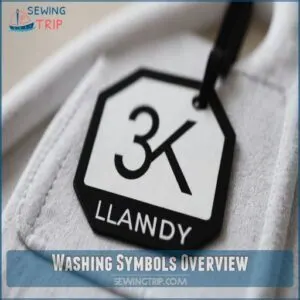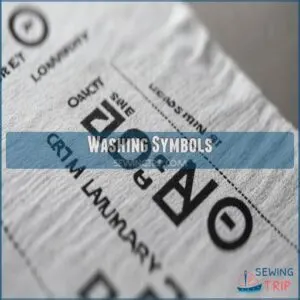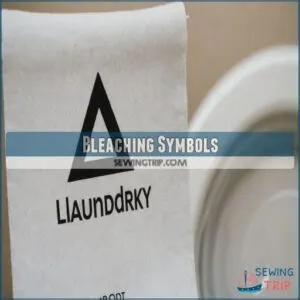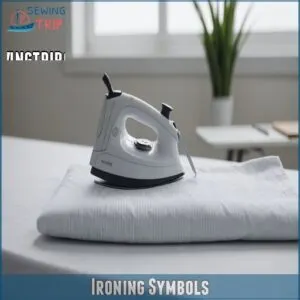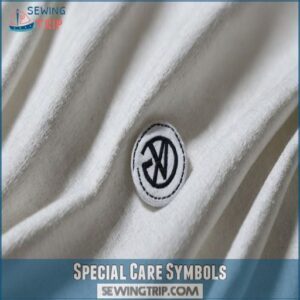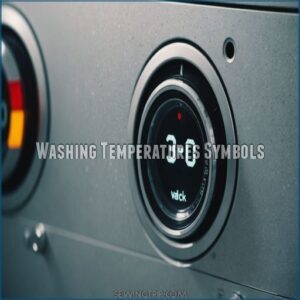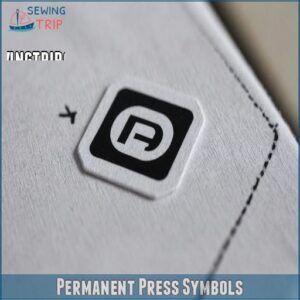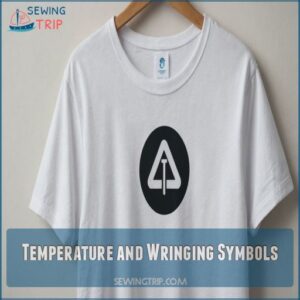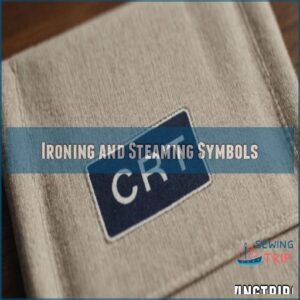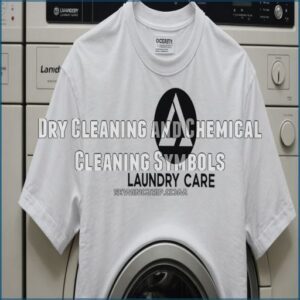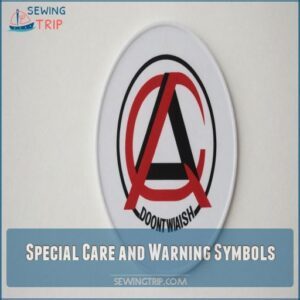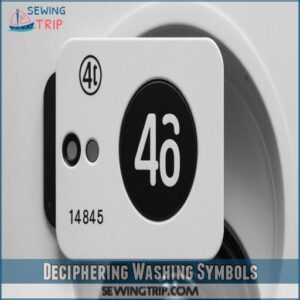This site is supported by our readers. We may earn a commission, at no cost to you, if you purchase through links.
 Ever felt like you’re decoding ancient hieroglyphics when looking at laundry tags?
Ever felt like you’re decoding ancient hieroglyphics when looking at laundry tags?
You’re not alone!
Washing symbols meaning can be a real head-scratcher, but they’re your secret weapon for keeping clothes in tip-top shape.
These little icons are like a cheat sheet for laundry care.
You’ll find symbols for washing (a tub), drying (a square), ironing (an iron), bleaching (a triangle), and dry cleaning (a circle).
Each one tells you exactly what to do – or not do – with your garment.
It’s like having a tiny laundry expert right on your clothes tag.
Mastering these symbols can save you from shrinkage nightmares and color-bleeding disasters.
But there’s more to these cryptic codes than meets the eye…
Table Of Contents
- Key Takeaways
- Washing Symbols Overview
- Laundry Symbol Categories
- Tub Symbols and Washing Instructions
- Bleaching and Drying Symbols
- Temperature and Wringing Symbols
- Ironing and Steaming Symbols
- Dry Cleaning and Chemical Cleaning Symbols
- Special Care and Warning Symbols
- Deciphering Washing Symbols
- Best Practices for Washing Symbols
- Frequently Asked Questions (FAQs)
- Conclusion
Key Takeaways
- Decoding washing symbols on clothing tags helps you avoid common laundry mishaps like shrinking or damaging your garments by indicating the correct washing, drying, and ironing methods.
- The tub symbol represents washing instructions, the triangle indicates bleaching, the square shows drying guidelines, and the iron specifies ironing details.
- Use dots inside the tub symbol to determine the water temperature; one dot means cold water, more dots indicate warmer temperatures.
- Checking and following fabric care symbols ensures your clothes maintain their quality and longevity, saving you from regrets and ruined clothes.
Washing Symbols Overview
You’ve probably noticed those mysterious symbols on your clothing tags and wondered what they mean—don’t worry, they’re not secret codes from a spy movie!
These washing symbols are simple guides to help make sure your clothes are washed correctly, keeping them looking great and lasting longer.
International Laundry Care Symbols
Ever wondered about those cryptic laundry symbols?
They’re not as mysterious as they seem!
While some symbol variations exist, global standards aim for universal understanding.
You’ll find country-specific symbols reflecting cultural differences in laundry habits.
Understanding these washing symbols, drying symbols, and care labels empowers you to take control of your clothes’ care.
Mastering these symbols helps you avoid shrinking your favorite sweater!
It’s all about extending the life of your clothes.
Machine Wash Symbols
You’ve mastered the art of deciphering international laundry symbols, now let’s unravel machine wash symbols.
These icons guide your washing adventures, especially when checking water temperature levels like dots in the washtub symbol.
- Machine wash cycles: Different symbols indicate various settings.
- Water temperature: Dots hint at the perfect heat level.
- Fabric types: Match symbols to your clothing’s needs.
Think of
Hand-wash Symbols
When you spot the hand-wash symbol, it means your fabric needs gentle attention.
Picture the wash tub with a hand hovering above.
Use cool water and a mild soap to pamper delicate fabrics.
Knowing how to remove stubborn stains like cat spray can be helpful too removing cat spray.
Gently swish, don’t wring, then lay flat to dry.
These washing instructions keep your treasures pristine, avoiding
Laundry Symbol Categories
You’d be surprised how much laundry symbols can tell you if you know what to look for!
By decoding categories like washing, bleaching, drying, ironing, and special care, you can keep your clothes looking their best without a mishap.
Washing Symbols
Wading through washing symbols can feel like cracking a secret code.
Not to worry! These icons guide you on the best way to wash your clothes, ensuring longevity and freshness.
Here’s a quick guide:
- Machine Wash: Tub icon means safe for machine wash.
- Hand Wash: A tub with a hand.
- Do Not Wash: Crossed-out tub.
- Temperature Settings: Dots indicate water temperature.
Bleaching Symbols
Bleaching symbols, those tricky triangles, can be your laundry’s best friend or worst enemy.
A plain triangle? Go ahead, use bleach cautiously.
A triangle with lines means non-chlorine bleach only.
Got a solid triangle with a big X? Put down the bottle—no bleach allowed!
Always check these laundry symbols for fabric protection and avoid unexpected disasters.
Drying Symbols
Decoding drying symbols can feel like deciphering a laundry maze.
With clever drying tips, understand these icons:
- Tumble Dry: A circle in a square lets you know it’s safe.
- Line Dry: Curved line suggests hanging outside.
- Dry Flat: Two diagonal lines mean lay it flat.
- Drip Dry: Vertical lines indicate no wringing.
Now you’ve disentangled the dryer settings mystery!
Ironing Symbols
Since ironing’s a big part of garment maintenance, let’s tackle those ironing symbols!
Understanding them helps you avoid ruining your clothes.
Here’s a handy guide:
| Symbol | Meaning | Ironing Safety Tip |
|---|---|---|
| No Iron | Don’t iron! | Always check labels before ironing. |
| Low Heat (*) | Low temperature ironing | Use a pressing cloth for delicate fabrics. |
| Med Heat (**) | Medium temperature ironing | Test on an inconspicuous area first. |
| High Heat (***) | High temperature ironing | Ironing board protects your surface. |
| Steam Allowed | Steam ironing is okay | Avoid burning yourself with hot steam. |
| No Steam | Don’t use steam | Let the iron cool before storing. |
Special Care Symbols
Ever wondered what those mysterious symbols on your clothes mean?
Special care symbols are like secret codes for laundry.
They guide you on delicate fabrics, indicating “dry clean only” or special hand wash tips.
These icons prevent mishaps like shrinking or color bleeding, ensuring your garment stays fabulous.
Don’t ignore them—your favorite sweater will thank you later!
Tub Symbols and Washing Instructions
With tub symbols, it’s like mastering your washing machine’s secret language, ensuring your clothes get the right treatment every time.
Learning these icons helps you decide whether to crank up the heat, take it easy with a gentle cycle, or opt for the permanent press setting.
Washing Temperatures Symbols
Let’s unravel washing temperature symbols.
They guide you through the tempest of laundry with ease.
One dot on your washing tub means cold water washing at 30°C, ideal for delicate fabrics to avoid damage.
More dots, more heat—up to five dots for hot water washing at 70°C.
By understanding these washing symbols, your laundry routine becomes as smooth as silk.
Gentle Cycle Symbols
Imagine spotting two lines under the wash tub symbol—it’s waving the gentle cycle flag!
This means your delicate fabrics, like modal fabrics that require special care to prevent color fading and maintain their softness, are in safe hands, or rather, the machine’s gentle spin.
Choose this cycle for a tender touch on clothes that need extra care, especially when washing modal fabrics that benefit from cold water washing methods.
Choose this cycle
Permanent Press Symbols
Gentle cycles offer finesse, but let’s focus on permanent press symbols.
Spot these washing symbols to care for permanent press fabric, which can be found at online stores like permanent press products.
They promise wrinkle-free care and relaxed dryer settings.
Use them to extend clothing maintenance without excessive ironing.
This laundry guide simplifies washing symbols, so you’re never left guessing fabric types or iron
Bleaching and Drying Symbols
You know those small triangle and square icons on your clothing care labels?
They’re your best friends for understanding when you can bleach or dry them without turning your favorite shirt into a science experiment gone wrong!
Bleaching Allowed Symbols
Now that you’ve mastered washing temperatures, let’s tackle bleaching!
A plain triangle on your laundry label means you’re good to go with bleach. But remember, it’s best to dilute it.
- Always check the fabric’s colorfastness first.
- Use a non-chlorine bleach for delicate fabrics.
- Proper bleach dilution prevents damage.
- This helps with stain removal and keeps your clothes looking great!
Bleaching Not Allowed Symbols
Spotting that triangle with an X over it? That’s your cue to put the bleach back on the shelf!
These symbols boldly warn you to skip bleach for fabric preservation, ensuring vibrant colors last without the headache of dye transfer.
Embrace bleach-safe alternatives for stain removal, keeping your wardrobe bright and beautiful.
Mastering laundry symbols makes fabric care a breeze!
Chlorine Bleach and Non-Chlorine Bleach Symbols
Deciphering bleach symbols feels like cracking a secret code.
Spot a plain triangle? It means you can use chlorine bleach, perfect for those white socks.
But, a triangle with diagonal lines? Stick to non-chlorine bleach to keep colors vibrant.
Keeping tabs on these symbols avoids fabric damage, maintains colorfastness, and gives you control over washing instructions and overall fabric care.
Tumble Dry Symbols
Feeling like you’re solving a puzzle when reading laundry labels?
Tumble dry symbols unravel that mystery.
Recognize them to make the right move.
A circle within a square hints at dryer use, while dots guide heat levels—one for low, two for medium.
Remember, ignoring these signs could lead to fabric damage or clothes shrinking as fast as a weekend goes.
Hang to Dry Symbols
Got a load that’s not for the dryer?
Let’s talk hang-to-dry symbols.
You’ll see these often after tackling tumble dry icons.
Here’s the scoop:
- Line Dry: Suspend your clothes outdoors; let nature do the job.
- Drip Dry: Avoid wringing, just hang.
- Dry Flat: Keep your knits flat to stop stretching.
Temperature and Wringing Symbols
Whether you’re tackling a mountain of dirty clothes or just trying to keep your favorite sweater in top shape, understanding temperature and wringing symbols is key.
These symbols act like your laundry’s secret language, telling you how hot the water should be and whether you can safely twist that shirt you love.
Washing Temperature Symbols
When deciphering washing temperature symbols, dots tell you the water heat level for washing.
One dot means cold water at 30°C, which helps prevent fabric shrinkage and is especially suitable for washing delicate fibers like viscose fabric care.
Two or three dots, indicating warmer temps, might suit tougher stains but pose hot wash risks.
Adjusting washing machine settings to match these symbols keeps your clothes safe and
Wringing Symbols
Two common wringing symbols exist: a simple towel icon means you can wring it out; a crossed-out towel means don’t wring it.
Understanding these wringing symbols is important to textile care, especially when working with delicate fabrics that require pre-washing fabrics before sewing.
Wringing too hard can damage delicate fabrics.
Consider your washing machine settings, opting for gentler cycles when washing such fabrics.
Wringing Instructions
Let’s face it, not all clothes are created equal, especially when those wringing symbols want to have a word.
The towel symbol permits wringing, but if crossed out, consider gentler wringing techniques or hand-wringing tips.
Mastering basic sewing skills, like threading the sewing machine, can also come in handy when repairing delicate items that might require squeezing rather than twisting.
Delicate items might
Ironing and Steaming Symbols
Regarding ironing and steaming your clothes, understanding the symbols can save you from accidentally torching your favorite shirt.
You’ll learn to easily identify whether items can be ironed at low, medium, or high temperatures, and if steaming is a no-go.
Ironing Allowed Symbols
Ironing symbols on your laundry tags might seem cryptic at first, but they’re your guide to fabric smoothness without the scorch risk.
An iron symbol with no extra lines means it’s all systems go for steaming or dry ironing.
Remember, though, different fabrics need different treatments; you wouldn’t want to iron your delicates the same way as your sturdy denim!
Low, Medium, and High Iron Temperature Symbols
Just as you’ve got the hang of ironing symbols, let’s tackle iron temperatures.
When you see one, two, or three dots inside your iron symbol, they signal the heat level you should stick to: low, medium, or high.
Recognizing these dots helps prevent heat damage to fabric types, ensuring your clothes stay crisp, while your steam iron adds that perfect finishing touch.
Do Not Iron Symbol
Switching gears from using low, medium, and high heat settings, let’s chat about the "Do Not Iron" symbol.
This icon means your garment is allergic to heat.
Consider these alternatives:
- Hang clothes to dry naturally.
- Steam them while showering.
- Use wrinkle spray for a smooth finish.
- Opt for a fabric refresher to freshen up.
Avoid those pesky heat damage risks!
Do Not Steam Symbol
Picture the "Do Not Steam" symbol: an iron with two crossed-out lines underneath.
It’s a heads-up to skip the steam, preventing steam damage on delicate fabrics or specific heat-sensitive materials.
When wrinkle removal is a must, explore iron alternatives or adjust heat settings.
Don’t forget, dry cleaning symbols might hint at professional handling.
Dry Cleaning and Chemical Cleaning Symbols
Ready to conquer those confusing dry cleaning symbols?
We’ll show you how to understand the different icons, so you can confidently send your clothes to the cleaners—and get them back looking their best!
Dry Cleaning Symbols
Dry cleaning symbols can feel like a secret language, but understanding them keeps your clothes in top shape.
A circle hints at professional cleaning.
A circle with an "x" warns, "Do not dry clean."
Remember, each symbol saves a misstep like using the wrong chemicals.
Learn the mysteries with this cheat sheet:
- Circle: Professional cleaning required
- "P": Restricted solvents only
- "F": Petroleum-based solvents only
- Circle with "x": No dry cleaning
Liquid Cleaning Symbols
When you’re browsing through laundry care labels, those liquid cleaning symbols can feel like hieroglyphics.
Understanding them helps you keep your clothes pristine.
A circle often means dry cleaning is recommended, while an "X" over it says no-go!
For specific chemical cleaning instructions, check out chemical cleaning symbols.
Professional cleaning guarantees garment care without risks.
So avoid shortcuts, and remember, a solvent
Solvents and Wet Clean Symbols
You’ve glanced at liquid cleaning symbols, now let’s untangle dry cleaning mysteries.
Those circles with letters? They guide your cleaner on solvent choices.
"A" means any solvent, while "P" signifies a few are off-limits.
Next time you’re tempted to handwash that jacket, remember professional cleaning options might save both fabric and sanity!
Treat your wardrobe wisely and enjoy the freedom.
Special Care and Warning Symbols
Laundry care symbols, like "Do Not Dry Clean" or "Delicate Care," can make all the difference in keeping your clothes looking their best.
These warning icons might seem intimidating, but once you crack their code, you’ll prevent disasters and extend the life of your favorite garments—like that time you turned a wool sweater into doll-sized clothing because of a missed "Do Not Wash" icon!
Do Not Dry Clean Symbols
Let’s switch gears from dry cleaning to its counterpart.
The ‘Do Not Dry Clean‘ symbol is a circle with an X – it’s your garment’s way of saying "Keep me away from those chemicals!"
Here’s why some clothes can’t handle the dry cleaning process:
- Delicate fabrics may shrink or lose shape
- Special finishes or embellishments could be damaged
- Certain dyes might bleed or fade
Instead, try these home alternatives: hand washing, gentle machine cycles, or spot cleaning for stains.
Your clothes will thank you!
Do Not Wash Symbols
Some garments aren’t meant for washing.
The "Do Not Wash" symbol is your red flag for these special items.
It’s a crossed-out washtub that screams, "Keep me dry!"
Here’s a quick guide to help you navigate these tricky care labels:
| Symbol | Meaning | What to Do |
|---|---|---|
| | Do Not Wash | Dry clean only |
| | Do Not Wet | Avoid water contact |
| 識❌ | No Detergent | Use specialized cleaner |
| ️❌ | No Hand Washing | Professional care needed |
| ❌ | No Machine Wash | Seek alternative cleaning |
Remember, these symbols are your clothing’s way of saying, "Handle with care!
Do Not Iron Symbols
Understanding the "Do Not Iron" symbol is important for preventing fabric damage.
This crossed-out iron icon means your garment can’t handle the heat.
To care for these items:
- Use alternative wrinkle-removal methods like steaming
- Opt for a dryer with a wrinkle-release cycle
- Hang clothes immediately after washing to minimize creases
Remember, heat-sensitive fabrics like silk or synthetic blends often sport this symbol.
By following these care label tips, you’ll keep your clothes looking fresh without risking heat damage.
Delicate Care Symbols
Delicate care symbols are your clothes’ way of saying, "Handle with care!"
You’ll spot a wash tub with a hand or two lines underneath for delicate fabrics.
These icons signal gentle hand-wash techniques or a delicate machine cycle.
For dry cleaning alternatives, look for a circle with a line.
Remember, ironing precautions often accompany these symbols.
Treating your delicates right isn’t rocket science—it’s just a matter of decoding these little laundry lifesavers!
Deciphering Washing Symbols
You’re about to become a laundry symbol expert, ready to crack the code on those tiny hieroglyphics hiding in your clothes tags.
With this guide, you’ll learn to decipher both common and rare washing symbols, ensuring your favorite outfits stay in tip-top shape.
Common Washing Symbols
You’ve mastered the special care symbols, now let’s tackle the everyday heroes of your laundry routine.
Common washing symbols are your clothes’ way of whispering their care secrets.
That little tub icon? It’s giving you the green light for machine washing.
Numbers inside the tub are your temperature guides.
A hand in the tub means it’s time for some TLC with hand washing.
Here are three symbols you’ll see often:
- Tub with a wave: Machine wash, regular cycle
- Tub with one line: Permanent press cycle
- Tub with two lines: Gentle cycle
Remember, these symbols are your laundry lifesavers!
Uncommon Washing Symbols
While you’re now a pro at common washing symbols, let’s unravel some of the more puzzling laundry hieroglyphics.
These rare symbols might make you feel like you’re decoding an ancient language, but don’t worry – we’ve got your back!
| Symbol | Meaning | Action |
|---|---|---|
| with dots | Reduced moisture | Use lower spin cycle |
| with squiggles | Natural drying | Air dry in shade |
| with ‘W’ | Wet clean | Professional wet cleaning |
Remember, these uncommon symbols are like secret handshakes in the laundry world.
They might seem confusing at first, but once you crack the code, you’ll be handling even the most finicky fabrics like a pro.
Best Practices for Washing Symbols
You’ll save time and money by following washing symbols correctly, treating your clothes like the VIPs they are.
Check those fabric labels before tossing your favorite shirt in the wash, and you’ll avoid turning your wardrobe into a collection of shrunken, faded memories.
Following Washing Instructions
Following washing instructions is like cracking a secret code for fabric care.
Don’t wing it!
Stick to those tiny symbols to keep your clothes looking fresh.
Mix up the wash cycle, and you might end up with a shrunken sweater or a tie-dyed disaster.
Trust the icons – they’re your laundry lifeline.
By playing by the rules, you’ll extend your wardrobe’s lifespan and dodge those "oops" moments.
Checking Fabric Labels
Fabric labels are your garment’s secret diary, spilling the beans on proper care.
Don’t let label confusion trip you up!
Take a moment to decode these tiny textile tales before tossing your clothes in the wash.
Here’s your label-reading cheat sheet:
- Look for washing machine usage and wash cycle instructions
- Check for tumble drying symbols or line drying symbols
- Spot hand washing symbols for delicate items
- Note any special care tips to avoid fabric care mishaps
Avoiding Damage to Garments
Your clothes’ longevity hinges on decoding those tiny symbols.
Don’t let laundry day turn into a fabric funeral!
Pre-treat stains before they set, and always sort by color and fabric type.
Watch out for sneaky laundry mistakes like overloading the machine or using too much detergent.
When in doubt about tumble drying symbols, opt for line drying.
It’s better to play it safe than shrink your favorite sweater!
Frequently Asked Questions (FAQs)
What do washing and laundry symbols mean?
Laundry symbols are your clothes’ secret language.
They guide you on washing, drying, and ironing.
Tubs mean washing methods, triangles for bleaching, squares for drying, and irons for, well, ironing.
Decode them to keep your wardrobe happy!
What does a washtub symbol mean?
Like Poseidon’s trident commanding the seas, the washtub symbol reigns over your laundry routine.
It’s the green light for machine washing.
Temperature dots inside guide you: one for cool, more for warmer washes.
You’re now a laundry whisperer!
What do wash symbols mean?
Wash symbols are your clothes’ secret code.
They tell you how to clean, dry, and care for your garments.
From tubs for washing to triangles for bleaching, these little icons help you keep your clothes looking fresh and lasting longer.
What are washing instruction symbols?
Don’t get your knickers in a twist!
Washing instruction symbols are your clothes’ secret language.
They’re those tiny icons on care labels that guide you on how to clean, dry, and iron your garments without ruining them.
What are machine wash symbols?
Machine wash symbols are your laundry’s secret code.
You’ll spot a tub-like icon on care labels.
It might’ve dots (for temperature), lines (for cycle type), or a hand (for hand washing).
Decoding these keeps your clothes happy!
How do clothes washing symbols work?
Ever felt like decoding a secret language on your clothes?
Washing symbols are your laundry guide.
They’re tiny icons that tell you how to wash, dry, and iron your garments.
You’ll find them on care labels, ensuring your clothes stay in top shape.
What do all the laundry symbols mean?
Laundry symbols are your clothes’ secret code.
You’ll spot tubs for washing, triangles for bleaching, squares for drying, and irons for, well, ironing.
Each symbol guides you on how to keep your duds looking fresh and fabulous.
What are the symbols on a washing machine?
You’ll spot various symbols on your washing machine that guide your laundry routine.
They indicate wash cycles, temperature settings, and special features.
Understanding these icons helps you tailor each load, ensuring your clothes come out clean and undamaged.
What are the five basic care symbols?
Prepare to unravel the Enigma Code of laundry!
The five basic care symbols are washing (tub), bleaching (triangle), drying (square), ironing (iron), and dry cleaning (circle).
These hieroglyphs reveal the secrets to keeping your clothes pristine and long-lasting.
What is the 30 washing symbol?
The 30 washing symbol features a tub with a ’30’ inside.
It means you should wash your garment in cold water, around 30°C or 86°F.
This gentle cycle helps preserve colors and fabrics, saving energy too.
How do I interpret symbols on imported clothing?
Decoding those pesky clothing hieroglyphics can be a breeze!
Look for universal symbols: tubs for washing, triangles for bleaching, squares for drying, and irons for, well, ironing.
When in doubt, snap a pic and use a translation app.
What do the numbers inside washing symbols mean?
Numbers inside washing symbols tell you the maximum water temperature for washing.
They’re like setting the stage for perfect laundry—30°C for cool, 40°C for warm, and so on.
Stick to the numbers, and clothes will last longer!
Are washing symbols standardized across different countries?
You’d think washing symbols are universal, but they’re not!
Although many countries use similar symbols, variations exist.
The American Society for Testing and Materials (ASTM) helps standardize them internationally, so checking local guidelines is wise!
Can I ignore washing symbols if Im experienced?
Think you’re a laundry pro? Even experts should heed those symbols! Ignoring them risks ruining your favorite clothes.
Those little pictures aren’t just suggestions; they’re essential for garment care.
Following them guarantees your clothes last longer.
Conclusion
Think of washing symbols as your laundry’s GPS—guiding you through the cleaning process.
By understanding washing symbols meaning, you’re equipped to keep your clothes vibrant and intact.
Remember, these tiny icons aren’t just for decoration; they’re practical advice stitched into your garments.
Save yourself from laundry mishaps by taking a moment to decode these symbols.
With a keen eye and attention to these guides, you can extend your clothes’ lifespan while keeping them looking fresh.

